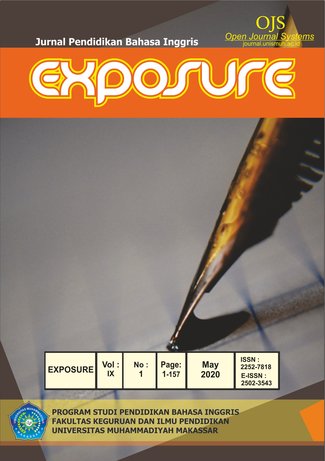BEYOND THE APPLICATION OF EDMODO IN CLASSROOM: STUDENTS’ PERCEPTIONS AND THEIR BARRIERS IN THE PROCESS OF UTILIZING IT IN WRITING CLASS
DOI:
https://doi.org/10.26618/exposure.v9i1.3429Keywords:
Students’ perceptions, Students’ barriers, Edmodo, WritingAbstract
This research was done to investigate the students’ perceptions and barriers in using Edmodo in their writing class. Besides, the barriers can be also the main points within the implementation of their writing class process. Edmodo is a free and secure learning platform that can be used in all lesson especially in university. It provides a very simple ways and simply make good pathway for teachers and students to communicate for a particular lesson especially for writing because the constructive comments were already stated within the platform. Since the focuses are perceptions of the students, a qualitative method was used through the use of documentation and interview were utilized to gather data. The findings showed that they strongly agreed that Edmodo very helpful in writing class, they can directly obtain the feedback, save their data safely and they can read it after a while and the rest perceptions will be explained more clearly.
References
Al-Kathiri, F. (2015). Beyond the classroom walls: Edmodo in Saudi secondary school EFL instruction, Attitudes and challenges. English Language Teaching, 8(1), 189–204. https://doi.org/10.5539/elt.v8n1p189
Al-Said, K. M. (2015). Students’ perceptions of Edmodo and mobile learning and their real barriers towards them. Turkish Online Journal of Educational Technology, 14(2), 167–180.
Holland, C., & Muilenburg, L. Y. (2011). Supporting Student Collaboration: Edmodo in the Classroom. Proceedings of Society for Information Technology & Teacher Education International Conference, 3232–3236.
Kongchan, C. (2008). How a Non-Digital-Native Teacher Makes Use of Edmodo. International Conference “ICT for Language Learning.”
Haygood, E., Garner, R. & Johnson, S. (2012). Blended Learning: Using Web 2.0S to enhance Classroom Instruction. Interlink Alliance. Retrieved October 10, 2013, from http://www.cehs.ohio.edu/
Cahyono, B.Y., & Rahayu, T. (2015). Using Video-based Tasks for Teaching Writing Process Analysis Essay. In B. Y. Cahyono (Eds), Inspiration and Innovations for English Classroom. Malang: State University of Malang Press.
Kusumaningrum, S.R. 2012. Utilizing “Watch-Wrap-Write” Technique to Assist Students in Writing an Argumentative Essay. Proceeding of the 5th TEFLIN International Conference: English Language Learning and Teaching in the Digitalization Era. Widya Mandala Catholic University Surabaya, 6-8 November 2012.
Downloads
Published
Issue
Section
License
Authors who publish with this journal agree to the following terms:
In order to assure the highest standards for published articles, a peer review policy is applied. In pursue of the compliance with academic standards, all parties involved in the publishing process (the authors, the editors and the editorial board and the reviewers) agree to meet the responsibilities stated below in accordance to the Journal publication ethics and malpractice statement.
Duties of Authors:
- The author(s) warrant that the submitted article is an original work, which has not been previously published, and that they have obtained an agreement from any co-author(s) prior to the manuscript’s submission;
- The author(s) should not submit articles describing essentially the same research to more than one journal;
- The authors(s) make certain that the manuscript meets the terms of the Manuscript Submission Guideline regarding appropriate academic citation and that no copyright infringement occurs;
- The authors(s) should inform the editors about any conflict of interests and report any errors they subsequently, discover in their manuscript.
Duties of Editors and the Editorial Board:
- The editors, together with the editorial board, are responsible for deciding upon the publication or rejection of the submitted manuscripts based only on their originality, significance, and relevance to the domains of the journal;
- The editors evaluate the manuscripts compliance with academic criteria, the domains of the journal and the guidelines;
- The editors must at all times respect the confidentiality of any information pertaining to the submitted manuscripts;
- The editors assign the review of each manuscript to two reviewers chosen according to their domains of expertise. The editors must take into account any conflict of interest reported by the authors and the reviewers.
- The editors must ensure that the comments and recommendations of the reviewers are sent to the author(s) in due time and that the manuscripts are returned to the editors, who take the final decision to publish them or not.
Authors are permitted and encouraged to post online a pre-publication manuscript (but not the Publisher’s final formatted PDF version of the Work) in institutional repositories or on their Websites prior to and during the submission process, as it can lead to productive exchanges, as well as earlier and greater citation of published work (see The Effect of Open Access). Any such posting made before acceptance and publication of the Work shall be updated upon publication to include a reference to the Publisher-assigned DOI (Digital Object Identifier) and a link to the online abstract for the final published Work in the Journal.

